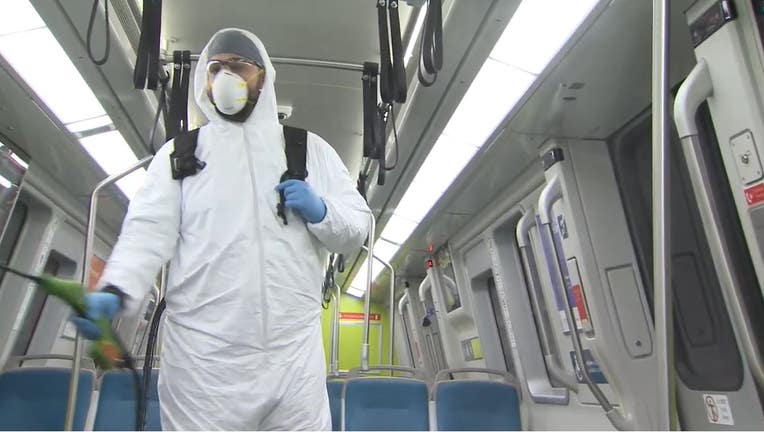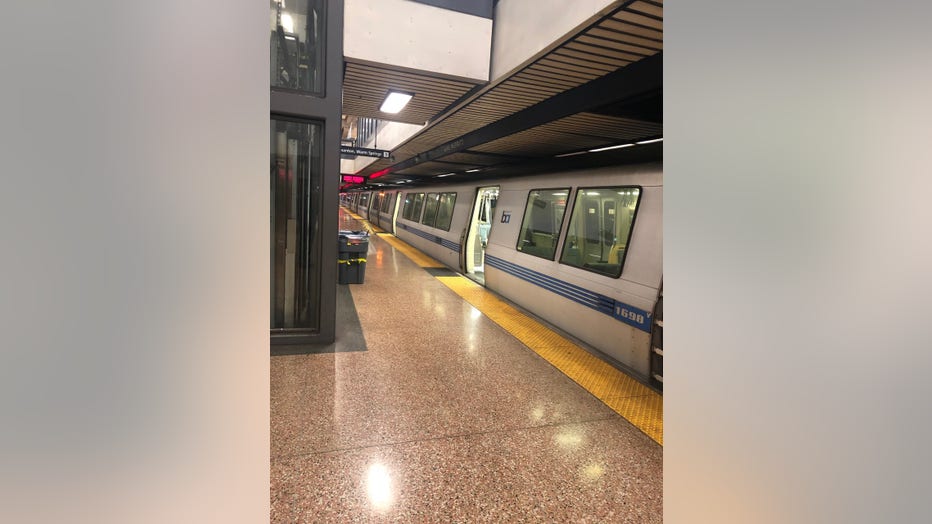BART unveils 15-step plan for service as shelter restrictions ease

BART being disinfected by a worker. Snap shot of video on BART.gov.
OAKLAND, Calif. - BART unveiled a 15-step plan Wednesday to renew passenger
confidence in the safety of riding public transit amid the COVID-19
coronavirus pandemic.
The plan continues and builds on the health and safety protocols
BART enacted as the pandemic began in earnest in mid-March, including more frequent disinfection and sanitization of train cars and stations and making hand sanitizer available at all stations.
The agency has procured enough hospital-grade disinfectant misters to fully disinfect each train car each night, which BART General Manager Bob Powers said should give passengers peace of mind as they try to avoid spreading or catching the coronavirus.

The Lake Merritt BART station was virtually a ghost town on the first shelter-in-place day for Oakland. March 17, 2020
"If I can put a system out there that is safe and disinfected and
clean and I can articulate that to the riders and provide that option, I can shape our ridership and the return to BART," Powers said.
BART is currently running trains every 30 minutes on weekdays, and all trains will include 10 cars whenever possible to allow for maximum physical distancing. BART officials estimate train cars can hold up to 30 passengers standing 6 feet apart or up to 60 passengers standing 3 feet apart.
As the agency's ridership increases, Powers said BART will be able to add more frequent train service across the system to maintain that capacity for physical distancing.
On the agency's new generation of train cars, BART plans to pilot
modular seating to create additional space for riders. Similar seating options will not be available on the system's older train cars. There are about 120 "Fleet of the Future" cars currently in service, according to Powers.
"We think that piloting this with the Fleet of the Future will
have a very positive impact on the social distancing," Powers said.
Face coverings will be required on all trains in accordance with
Bay Area public health guidelines and BART police are expected to enforce that requirement both aboard trains and at each station. BART will also install signs and markers reminding passengers of best health and safety practices.
With significantly reduced revenue down about 90 percent from
BART's projections due to low ridership, the agency expects to maintain a "very precariously balanced" budget for fiscal year 2020-2021, according to Powers.
"It absolutely relies quite heavily on (Coronavirus Aid, Relief,
and Economic Security Act) funding," he said. The CARES Act included some $25 billion in relief funding for transit agencies across the country.
The proposed budget, which the agency's Board of Directors will
discuss at its meeting Thursday, does not include furloughs or layoffs as currently constructed, according to Powers, who said the agency's budgets for the next two fiscal years will be "unequivocally" dependent on funding included in a future federal stimulus package.
As the Bay Area's economy reopens, BART officials plan to work
with employers to encourage staggered shifts, which would reduce crowding during peak morning and evening commute hours. The agency is also providing its employees with personal protective equipment and coronavirus testing to ensure they remain healthy and able to maintain the transit system.
"We need to be there for when the economy starts to reopen and
re-energize itself," Powers said.
Riders are encouraged to use touchless payment methods across the BART system such as a Clipper card as often as possible. BART riders can also obtain a personal hand strap, allowing them to avoid touching hand rails, by calling (510) 464-7136 or visiting the customer service window at the Lake Merritt station.
More information about the 15-step plan can be found online at
https://www.bart.gov/news/articles/2020/news20200526.

